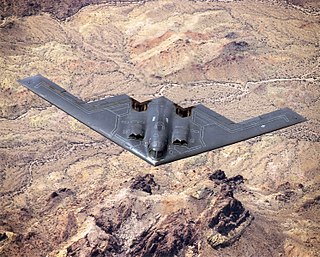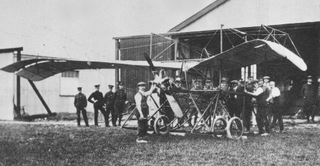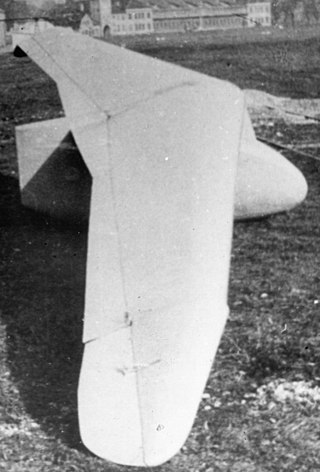
A flying wing is a tailless fixed-wing aircraft that has no definite fuselage, with its crew, payload, fuel, and equipment housed inside the main wing structure. A flying wing may have various small protuberances such as pods, nacelles, blisters, booms, or vertical stabilizers.

The DFS 194 was a rocket-powered aircraft designed by Alexander Lippisch at the Deutsche Forschungsanstalt für Segelflug.

The Northrop N-1M, also known by the nickname "Jeep", is a retired American experimental aircraft used in the development of the flying wing concept by Northrop Aircraft during the 1940s.

The Northrop XP-56 Black Bullet was a unique prototype fighter interceptor built by the Northrop Corporation. It was one of the most radical of the experimental aircraft built during World War II. Ultimately, it was unsuccessful and did not enter production.

Winged tanks were the subject of several unsuccessful experiments in the 20th century. It was intended that these could be towed behind, or carried under, an airplane, to glide into a battlefield, in support of infantry forces.

The General Aircraft GAL.48 Hotspur was a military glider designed and built by the British company General Aircraft Ltd during World War II. When the British airborne establishment was formed in 1940 by order of Prime Minister Winston Churchill, it was decided that gliders would be used to transport airborne troops into battle. General Aircraft Ltd were given a contract by the Ministry of Aircraft Production in June 1940 to design and produce an initial glider for use by the airborne establishment, which resulted in the Hotspur.

The Armstrong Whitworth A.W.52 was an early flying wing aircraft designed and produced by British aircraft manufacturer Armstrong Whitworth Aircraft.

The Baynes Bat was an experimental glider of the Second World War, designed by L. E. Baynes. It was used to test the tailless design that he had suggested as a means to convert tanks into temporary gliders so they could be flown into battle.

The Short SB.4 Sherpa was an experimental aircraft designed and produced by the British aircraft manufacturer Short Brothers. Only a single example was ever produced.

Pterodactyl was the name given to a series of experimental tailless aircraft designs developed by G. T. R. Hill in the 1920s and early 1930s. Named after the genus Pterodactylus, a well-known type of Pterosaur commonly known as the pterodactyl, all but the first were produced by Westland Aircraft Ltd after Hill joined them.
Geoffrey Terence Roland Hill, was a British aviator and aeronautical engineer.

The General Aircraft GAL.56 was a family of 1940s British experimental tailless swept wing glider designs.

The Kayaba Ku-2 was a glider built in Japan in 1940 to investigate the possibilities of tailless aircraft. It was developed as part of an Imperial Japanese Army contract that had been offered to designer Hidemasa Kimura following the successful flights of his HK-1 tailless glider over the previous years.
The Kayaba Ku-3 was a glider built in Japan in 1941 to investigate the possibilities of tailless aircraft. Building on the success of the Ku-2 design of the previous year, the Ku-3 was a substantially larger aircraft with several novel features. The small vertical fins of the Ku-2 were abandoned, leaving the Ku-3 with no vertical control surfaces. The crescent wing had three pairs of control surfaces on the trailing edge. The outer, less-swept wing sections had a greater dihedral than the inner sections.

The Kayaba Ku-4 was a research aircraft built in Japan in 1940 to investigate the possibilities of tailless aircraft designs. It followed designer Hidemasa Kimura's successful Ku-2 and Ku-3 designs for the Imperial Japanese Army. While these previous aircraft had been gliders, however, the Ku-4 was to be powered by a pusher engine. It had a low, swept wing, and like the Ku-2, fins at the wingtips.

The Dunne D.7 was one of J. W. Dunne's swept wing tailless aircraft designed to have automatic stability, first flying in 1911. It was a single seat, single engined pusher monoplane developed from the unsuccessful D.6.

The Akaflieg München Mü5 Wastl is a glider that was designed and built in Germany in 1924.
The NRC tailless glider, also called the NRL tailless glider, was a two-seat tailless research glider designed by the National Research Council of Canada and built by the National Research Laboratories, at the instigation of G.T.R. Hill who had previously designed the British Westland-Hill Pterodactyl series of tailless aircraft.















